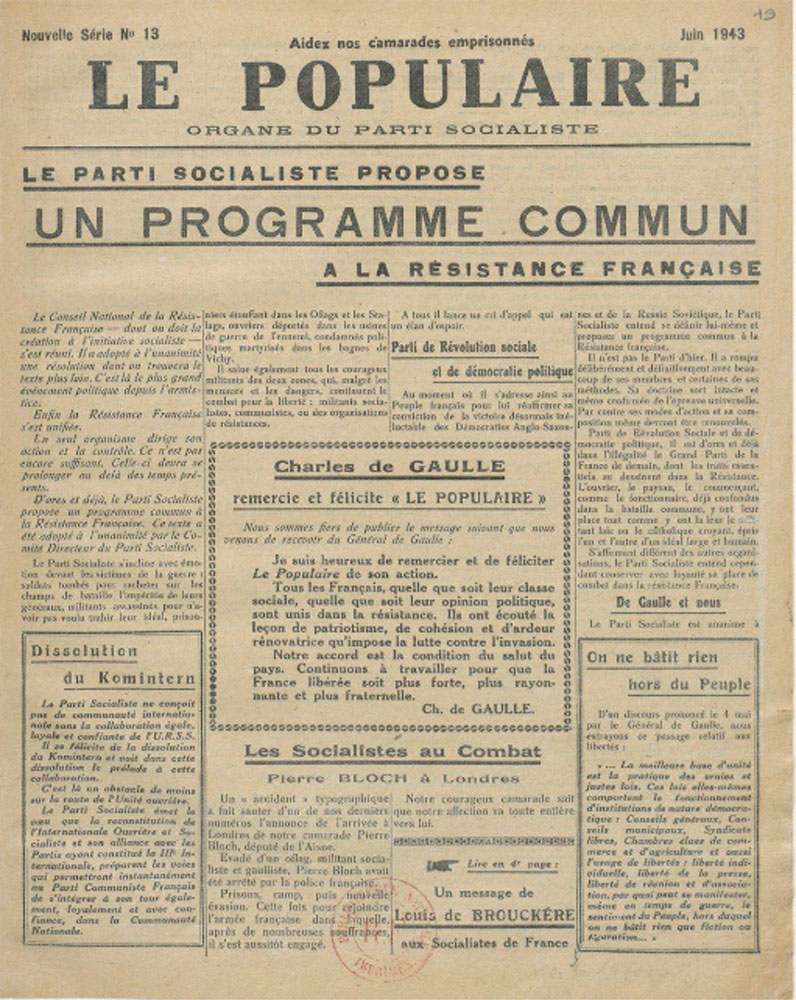Le Populaire, juin 1943
Légende :
Journal du Parti socialiste alors clandestin, Le Populaire, juin 1943
Le Populaire, June 1943, which was the underground Socialist Party's newspaper
Genre : Image
Type : Journal
Source : © Bibliothèque nationale de France - Gallica Droits réservés
Détails techniques :
Journal imprimé de quatre pages.
Date document : Juin 1943
Lieu : France
Analyse média
Dans sa une, Le Populaire, organe du Parti socialiste alors clandestin, appelle à un programme commun à la Résistance française. Il s'agit pour le Parti socialiste du deuxième appel semblable, le premier ayant paru cinq mois auparavant, dans le numéro de février 1943.
La dynamique de la discussion au sein du CNR est lancée par le commissaire national à l'Intérieur, André Philip, ex-député SFIO du Rhône, qui soumet au CNR, au mois de juillet 1943, un projet de texte rédigé à Londres. Ce texte, dont une partie s'appelle "Charte économique et sociale", ressemble aux projets du CAS (Comité d'Action Socialiste).*
On the front page of Le Populaire, the newspaper of the clandestine Socialist Party, they call for a joint program for the French Resistance. It was their second appeal of a similar nature, the first having been published five months before, in February 1943.
Within the CNR, a dynamic discussion was launched by the commissaire national à l’Intérieur (Home Commissioner), André Philip, former deputy to the SFIO of Rhône, who submitted a draft paper that had been written in London. The text, which became known as “Charte économique et sociale” (Economic and Social Chart),was very close to some of the CAS projects.
* Claire Andrieu in Dictionnaire historique de la Résistance, Robert Laffont, 2006.
Traduction : Gabrielle Ciceri
Contexte historique
Le Populaire, fondé par Jean Longuet - petit-fils de Karl Marx - en mai 1916, devient le 21 mars 1921 l'organe officiel de la SFIO, les communistes majoritaires gardant le contrôle de l'Humanité. Dirigé par Léon Blum et Jean Longuet, il est l'instrument privilégié de propagande du Parti, mais n'arrive pas à s'imposer. Manque de moyens financiers et concurrence de la presse socialiste de province, le quotidien devient bimensuel en 1924. Un nouveau Populaire quotidien est relancé en janvier 1927, qui paraîtra régulièrement jusqu'en juin 1940, passant de 4 à 6 voire 8 pages en fonction des rentrées financières et des aides de l'Internationale socialiste. Un supplément mensuel, la Vie du Parti, 1929-1940, encarté dans le journal, publie les textes principaux, les motions pour les congrès. Un autre supplément, Faits et chiffres, sort entre 1932-1934.
Après l'invasion allemande, Le Populaire cesse de paraître. Le Comité d'action socialiste (CAS) fondé par Daniel Mayer en mars 1941 se dote d'un organe, Socialisme et liberté, qui devient en mai 1942 Le Populaire clandestin. À la veille de la Libération, le journal tire à 70 000 exemplaires environ, selon un rapport anonyme de la SFIO clandestine. De l'été 1944 à l'été 1946, suivant le bref moment d'euphorie que connut la SFIO, Le Populaire devient l'un des principaux quotidiens parisiens par son tirage (263 000 exemplaires fin septembre 1944, deuxième diffusion nationale après L'Humanité), mais il décline rapidement par la suite. Robert Verdier assiste Blum à la direction de 1946 à 1950, puis lui succède jusqu'en 1954. Gérard Jaquet en assure un temps la direction avec Claude Fuzier comme adjoint, puis successeur. Dans les années 1960, les difficultés s'accroissent, et le journal doit cesser sa parution en février 1970.
Le Populaire newspaper, founded by Jean Longuet – the grandchild of Karl Marx – in May 1916, became the official newspaper of the SFIO on March 21st 1921 as the communist majority was keeping the entire control of newspaper L'Humanité. Managed by Léon Blum and Jean Longuet, it was the primary mode of propaganda for the Party, but never succeeded in imposing itself. Due to the lack of financial support and to the competition of other socialist provincial nespapers, the daily soon became bimonthly. A new daily Populaire was reintroduced in January 1927, which was published regularly until June 1940, consisting of 4 to 6, even 8 pages, depending on the influx of money and aid from the Socialist International. A supplemental monthly newspaper, la Vie du Parti, 1929-1940, was inserted into the newspaper, published with the main texts and motions before congress. An additional issue, Faits et chiffres, existed between 1932-1934.
After the German invasion, Le Populaire ceased to function. The Comité d’action socialiste (Socialist Action Committee, CAS) founded by Daniel Mayer in March 1941 was given a publication, Socialisme et liberté, which in May 1942 became Le Populaire clandestin. On the eve of the Liberation, the newspaper had published 70 000 copies according to an anonymous report by the underground SFIO. From the summer of 1944 to the summer of 1946, following a brief moment of euphoria that gripped the SFIO, Le Populaire became the most circulated Parisian daily (263 000 copies by the end of September 1944, second in national popularity only to L’Humanité), but it rapidly decreased following this. Robert Verdier assisted Blum in its management from 1946 to 1950, then he succeeded him, where he remained until 1954. Gérard Jaquet provided time management as an assistant and successor to Claude Fuzier. In the 1960s, the difficulties increased, and the newspaper folded in February 1970.
D'après le site de l'OURS (Office Universitaire de Recherche Socialiste) et Wikipédia.
Traduction : Gabrielle Ciceri

Journal-organe du Parti socialiste clandestin, Le Populaire, juin 1943, page 2
Bibliothèque nationale de France - Gallica
 Le Populaire, juin 1943, page 3
Le Populaire, juin 1943, page 3Journal-organe du Parti socialiste clandestin, Le Populaire, juin 1943, page 3
Bibliothèque nationale de France - Gallica
 Le Populaire, juin 1943, page 4
Le Populaire, juin 1943, page 4Journal-organe du Parti socialiste clandestin, Le Populaire, juin 1943, page 4
Bibliothèque nationale de France - Gallica



 Voir le bloc-notes
()
Voir le bloc-notes
()